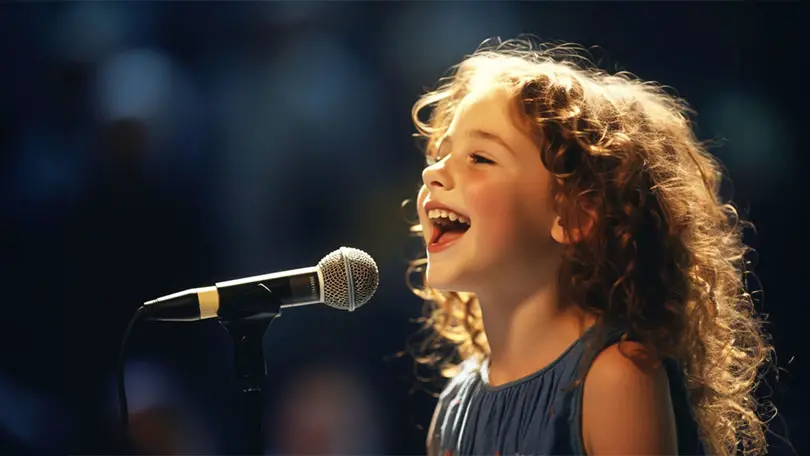The frequency ranges of human voices vary and can impact a vocal performance – and so, its sheet music.


Understanding the frequency ranges of different voices can be quite useful, whether you’re mixing a track in the studio, setting up microphones for a live performance, or even just arranging music for a group of singers. Each category of voice, whether male, female, or child, operates within specific frequency ranges that can significantly impact the clarity and effectiveness of vocal performance.
In this blog post, we’ll explore the unique vocal frequency ranges for males, females, and children, both in singing and talking, and discuss why sometimes it’s necessary to transpose music to suit young singers.
Table of Contents
Male Voices

Singing
Male voices in singing are typically categorized into bass, baritone, tenor, and countertenor. Each type has a distinctive range:
- Bass: The deepest male voice, with a range from about E2 (82 Hz) to E4 (330 Hz).
- Baritone: Sits between bass and tenor, ranging from A2 (110 Hz) to A4 (440 Hz).
- Tenor: The highest of the typical male voice types, spanning from C3 (130 Hz) to C5 (520 Hz).
- Countertenor: Often overlaps with the female alto and mezzo-soprano ranges, typically from E3 (165 Hz) to E5 (660 Hz).
Talking
The speaking voice of a typical adult male usually falls between 85 to 180 Hz, with a richer, more resonant quality in the lower frequencies. This range can vary widely based on individual vocal traits and the level of vocal training or exertion.
Female Voices

Singing
Female singing voices are generally classified as soprano, mezzo-soprano, or alto:
- Alto: The lowest standard female singing voice, spanning from F3 (175 Hz) to F5 (700 Hz).
- Mezzo-Soprano: A slightly lower range than the soprano, from A3 (220 Hz) to A5 (880 Hz).
- Soprano: The highest singing voice, which can range from C4 (middle C, 261 Hz) to C6 (1046 Hz).
Talking
Female speaking voices typically range from 165 to 255 Hz, which is generally higher than male voices. This higher pitch can give the female voice a brighter, lighter quality.
Children’s Voices

Singing
Children’s voices are notably higher and lighter than most adults, typically lacking the vocal power and range of mature voices. To better understand these differences, we can categorize children’s singing voices into two age groups:
- Younger Children (up to 6-7 years old)
The voices of younger children, up to about 6-7 years old, display a bright and clear quality. Their vocal range is generally more limited compared to older children.
Typical vocal ranges for this group extend from D4 (approximately 294 Hz), which is slightly above middle C, to D5 (approximately 587 Hz). This range encompasses the purity and simplicity characteristic of very young children’s voices. - Older Children (8 years old and above)
As children grow, their vocal capabilities develop, nearing the ranges typical of adult voices but without the full vocal power.- Boys: Prior to the breaking of their voices, their singing range can be roughly equivalent to adult female mezzo-sopranos, spanning from A3 (220 Hz) to A5 (880 Hz).
- Girls: Often able to sing a bit higher than boys, their typical range goes from C4 (middle C, 261 Hz) to C6 (1046 Hz), aligning closely with adult sopranos.
Talking
The speaking voice of children, whether male or female, tends to be higher than that of adults, generally ranging from 250 to 300 Hz. This higher pitch reflects the smaller physical size of their vocal cords.
Transposition in Music for Children

When arranging music for children, it’s often necessary to transpose pieces to accommodate their vocal range comfortably. This practice ensures that the music falls within a range that children can sing without strain, helping them to achieve a better tone and avoid damage to their developing vocal cords.
Transposition can involve shifting the music up or down in pitch to suit the children’s voice type and is especially important in choirs or ensemble settings where maintaining vocal health is crucial.
Understanding these frequency ranges is key to many aspects of music and audio production. For anyone working with different voices, whether in live performance settings, studio recordings, or educational contexts, recognizing and adapting to these ranges can significantly enhance the quality and effectiveness of vocal performances.
A Graph : Frequency Ranges of Human Singing Voices
The following graph offers a comprehensive visual representation of the frequency ranges for human singing voices across different genders and age groups.
It vividly illustrates the varying vocal capabilities from the deepest bass notes to the highest soprano pitches, encompassing the distinctive ranges of male, female, and children’s voices.

Notably, the graph employs an exponential scale rather than a linear one in its horizontal axis, effectively capturing the wide span of frequencies within each vocal category.
This choice in scaling emphasizes the significant shifts in pitch across the spectrum of human vocal expression, reinforcing the nuanced understanding required when working with diverse voices in music production, live performance, or educational settings.
Liked it? Pin it!

Did you like this post? Rate it!
You may also like:
Why Should Parents Sing Nursery Rhymes to their Children?
20 of the Best Bedtime Songs for Kids to Help Them Relax and Get Ready for Sleep

















